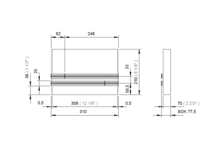T-Trak
T-Trak or TTrak is a standard for the modular construction of model railways , which comes from Japan and was originally developed for the layout of tram model systems in N gauge . The standard is based on the Unitrack rail system from the model railway manufacturer KATO , in which the track modules have a width of 308 mm (or multiples thereof) and a minimum depth of 210 mm (according to DIN A4 ) and are only interconnected by the rail connectors with a length of 310 mm are connected on each side by 1 mm protruding Unitrack rails. Two parallel tracks are run as main lines over the module, which are either placed directly next to each other (the Unitrack tracks have an integrated track slope, which ensures sufficient distance), primarily for tram layouts, or at a distance of 33 mm (track center to track center) according to the standard spacing of the Unitrack track system. The power supply between the modules is achieved via the rail connectors; In addition, underfloor connections can be used for better power supply by means of standard connecting tracks from Unitrack.
In addition to straight section modules, the standard includes inside and outside corner modules and branch modules.
The modules are 70 mm high and are intended to be placed on tables (table top, hence T-Trak).
In the USA the T-Trak has become quite popular lately and is an alternative to the larger and heavier N-Trak modules. There are now variants for other gauges, namely H0 .

